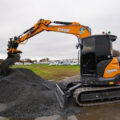~ Geobear’s exoskeleton trials offer insights into their role in improving employee health & safety during subsidence management ~
While exoskeletons won’t have you fighting kaiju like in Pacific Rim, they’re still a big step towards a safer, strain-free workday. So, move over Jet Jaguar, let exoskeletons combat the true monsters: repetitive stress and vibrational strain. Here, Malcolm Mearns, safety, health, environment and quality director at geotechnical contractor Geobear, explores the company’s recent exploration of exoskeletons as a tool to reduce musculoskeletal injuries to its workforce.
Geobear recently initiated a trial looking into using exoskeletons to reduce repetitive stress injuries in manual work environments. Establishing an in-house ergonomics working group, comprised of operational staff and technicians, the company aimed to enhance the ergonomics of subsidence drilling by mitigating strain from repetitive tasks. They first employed mechanical means using a hierarchical risk reduction approach, before trialling assistive exoskeleton technology.
Geobear’s subsidence management strategy involves drilling with progressively larger bits before inserting a 12 mm injection tube into the ground to inject a geo-polymer resin, combatting subsidence. Whether conducted manually or using a driving tube, this process requires repeated bending and movement in a downwards direction.
The exoskeleton, weighing 2.4 kg and composed of a plastic frame with a bicep-mounted pulley system, is designed to alleviate strain on the shoulders and neck during intensive work, such as continuous overhead tasks.
Geobear piloted the exoskeleton with a group of its technicians in the UK for live field testing. Feedback from the working group highlighted significant challenges, particularly with movement restriction. The exoskeleton works by shifting strain from the arms to the operator’s core, promoting correct posture. While perfect for tasks at shoulder level and above, during operations such as driving the injection tube into the ground, operators needed to lean forward. With the exoskeleton on, this caused discomfort. Additionally, the test group noted issues with the exoskeleton’s size, measuring 950 mm by 450 mm. This sizing posed challenges for larger operators, especially during the downward-facing drilling tasks.
These concerns show that while the suit might be suited for horizontal or vertical subsidence works, such as in tunnels, there was an increased risk of injury during downward drilling tasks. Due to these concerns, the exoskeleton will not be used while further technologies are trialled.

The need for effective health and safety protocols and innovations
According to the Health and Safety Executive (HSE), musculoskeletal injuries caused by repetitive strain accounted for a loss of 6.6 million workdays during the 2022/2023 period, making it the second leading cause of work-related absenteeism in the UK. It is injuries like these, and the commonality of them, that makes the continual adoption and evaluation of initiatives like these so important. By fostering a culture of innovation that supports employee wellbeing and operational excellence, risks can be mitigated and workplace conditions improved.

The future of safety
There is future potential for exoskeleton technology in various operational scenarios, particularly in horizontal and upward drilling tasks. Further trials with tool-balancing exoskeletons such as the Hilti EXO-T-22 could enhance ergonomics by reducing fatigue, shoulder strain and lower back pain through software that balances tool weights using a back-mounted winch. However, using this exoskeleton in cramped conditions, such as between residential properties, might be challenging.
Geobear is already pursuing advancements beyond exoskeleton trials. Efforts include modifying drill stands for manual attachment with off-road capabilities and reducing strain from carrying larger weights. There are also efforts to enhance tube driving efficiency through new tips designed for driving into clay, reducing vibration, manual labour and the potential for musculoskeletal injuries. By continuously seeking innovative solutions, and investing in R&D testing, companies can show commitment to continuous improvement in the health and safety of their people in the field.
So, while plans for technicians wearing monster-killing mech suits might have to be shelved until next year, Geobear’s exploration of exoskeletons has highlighted key ergonomic challenges and future potential for the suits. Despite some limitations with exoskeleton testing, Geobear’s culture to improve employee wellness and safety continues to explore new technologies.
To learn more about how Geobear manages subsidence visit geobear.co.uk/void-filling or contact a member of the team through the online form.








